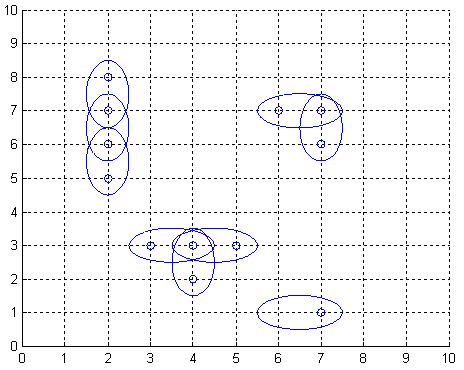| Time Limit: 1000MS | Memory Limit: 65536K | |
| Total Submissions: 6930 | Accepted: 3439 |
Description

Obviously, it is desirable to use as few antennas as possible, but still provide coverage for each place of interest. We model the problem as follows: Let A be a rectangular matrix describing the surface of Sweden, where an entry of A either is a point of interest, which must be covered by at least one antenna, or empty space. Antennas can only be positioned at an entry in A. When an antenna is placed at row r and column c, this entry is considered covered, but also one of the neighbouring entries (c+1,r),(c,r+1),(c-1,r), or (c,r-1), is covered depending on the type chosen for this particular antenna. What is the least number of antennas for which there exists a placement in A such that all points of interest are covered?
Input
Output
Sample Input
2 7 9 ooo**oooo **oo*ooo* o*oo**o** ooooooooo *******oo o*o*oo*oo *******oo 10 1 * * * o * * * * * *
Sample Output
17 5
题意:在一个h*w的矩阵中,*代表城市,o表示空地,城市需要覆盖无线网,若放置一个基站,可以覆盖相邻的两个城市,问最少要放置多少个基站才能将所有的城市覆盖。
思路:这道题目难点不是二分图的问题,却是建图的问题。到底是有向图还是无向图,因为这两个的建图方式是不同的,这道题是个有向图,这里不是把城市的x,y坐标当做点集,而是将一个一个的城市当做点集,构造方法如下(转)
例如输入:
*oo
***
O*o
时,可以抽象为一个数字地图:
100
234
050
数字就是根据输入的城市次序作为该城市的编号,0代表该位置没有城市。
然后根据题目的“范围”规则,从第一个城市开始,以自身作为中心城市,向四个方向的城市进行连线(覆盖)
因此就能够得到边集:
e12 e21 e32 e43 e53
e23 e34
e35
可以看到,这些边都是有向边,但是每一条边都有与其对应的一条相反边。
即任意两个城市(顶点)之间的边是成对出现的
那么我们就可以确定下来,应该 构造无向二分图(其实无向=双向)
把原有向图G的每一个顶点都”拆分(我认为复制更准确)”为2个点,分别属于所要构造的二分图的两个顶点集
那么同理就可以得到刚才的例子的 无向二分图为:

再继而通过无向二分图,以V1的元素作为row,V2的元素作为col,构造 可达矩阵 存储到计算机
1’ 2’ 3’ 4’ 5’
1 F T F F F
2 T F T F F
3 F T F T T
4 F F T F F
5 F F T F F
接下来就是要求这个 无向二分图的最小路径覆盖 了
利用公式:
无向二分图的最小路径覆盖 = 顶点数 – 最大二分匹配数/2。
#include <stdio.h>
#include <string.h>
#include <stdlib.h>
#include <iostream>
#include <algorithm>
using namespace std;
struct node {
int v,w;
int next;
} edge[10010];
int cnt,k;
int head[500];
int vis[500];
int link[500];
int map[100][100];
int jx[]= {-1,0,1,0};
int jy[]= {0,1,0,-1};
void add(int u,int v,int w) {
edge[cnt].v=v;
edge[cnt].w=w;
edge[cnt].next=head[u];
head[u]=cnt++;
}
int dfs(int u) {
int i;
for(i=head[u]; i!=-1; i=edge[i].next) {
int v=edge[i].v;
if(!vis[v]) {
vis[v]=1;
if(link[v]==-1||dfs(link[v])) {
link[v]=u;
return 1;
}
}
}
return 0;
}
int main() {
int T,i,j,l;
int h,w;
char str;
scanf("%d",&T);
while(T--) {
memset(head,-1,sizeof(head));
memset(link,-1,sizeof(link));
memset(map,0,sizeof(map));
k=0;
cnt=0;
scanf("%d %d",&h,&w);
for(i=1; i<=h; i++) {
for(j=1; j<=w; j++) {
cin>>str;
if(str=='*')
map[i][j]=++k;
}
}
for(i=1; i<=h; i++) {
for(j=1; j<=w; j++) {
if(map[i][j]) {
for(l=0; l<4; l++) {
if(map[i+jx[l]][j+jy[l]])
{
add(map[i][j],map[i+jx[l]][j+jy[l]],1);
add(map[i+jx[l]][j+jy[l]],map[i][j],1);
}
}
}
}
}
int sum=0;
for(i=1;i<=k;i++) {
memset(vis,0,sizeof(vis));
sum+=dfs(i);
}
printf("%d\n",k-sum/2);//无向二分图:最小路径覆盖数 = "拆点"前原图的顶点数 - 最大匹配数/2
}
}























 5559
5559











 被折叠的 条评论
为什么被折叠?
被折叠的 条评论
为什么被折叠?










